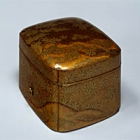Japanese Gallery (Honkan) Room 14
January 2, 2011 (Sun) - February 20, 2011 (Sun)
Fragrances have beneficial effects, such as calming the mind and refreshing the spirit. Japan has had a culture of utilizing aromatic effects since ancient times, and pastimes centering on the enjoyment of incense developed significantly from the Muromachi period (1392-1573) onward. Many incense utensils are characterized by a novel appeal free from formality.
In particular, kumiko, a game of guessing combinations of incense wood as it is burned as mixtures, used unique game pieces which were playful in appearance. Shaped after items such as dolls and flowers, these pieces were placed on game boards where they were moved and taken by players as they scored correct answers to determine the winner. Kumiko game sets are often similar to delicate miniature models.
Boxes for incense wood, along with smaller containers for incense mixtures, are also noteworthy for their liberal and distinctive designs. Larger boxes (often known as jinbako) contain smaller incense containers at times, while the smaller containers (often known as kogo) were produced in shapes such as bells, drums, fans, and chests which pilgrims carried on their backs. Small in size yet unique, they were cherished for the wide variety of their forms.
This exhibition also introduces tools used to cut incense wood into chips, along with incense burners and ash receptacles to keep the used pieces. Even the smallest implements were decorated in intricate detail, using maki-e and other lacquerwork techniques. Enjoy the elegant world of fragrance through these exquisite works of decorative art.

